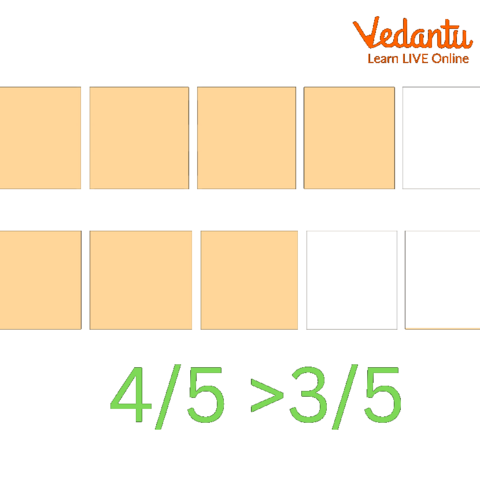




How to Arrange Fractions in Descending Order: Proven Methods
An element of a whole is a fraction. The number is represented mathematically as a quotient, where the numerator and denominator are divided. Both are integers in a simple fraction. A fraction appears in the numerator or denominator of a complex fraction.
Before being ordered in ascending and descending order, the fractions might first be expressed as similar fractions. Fractions having the same denominator are said to be like fractions. To arrange the fractions in order, we shall change them to like fractions.

Decreasing Order of Height for Different Animals
What are Like and Unlike Fractions?
Based on the denominators, there are two basic categories of fractions: like fractions and unlike fractions. Like fractions are those in which two or more fractions have the same denominator, and unlike fractions are those in which two or more fractions have distinct denominators. For example, \[\frac{1}{2}\] and \[\frac{3}{2}\] are like fractions and \[\frac{1}{9}\] and \[\frac{3}{7}\] are unlike fractions.
Steps to Convert the Fractions in Descending Order:
There are two ways we can arrange the fraction in descending order.
The first process involves comparing each fraction's denominator to see if they are equal before arranging and comparing the numerators.
The second method is converting the given fractions to decimals before comparison and arrangement.
In the first method, all the specified fractions' denominators will be checked. Simply compare the numerator and arrange fractions based on it if all the denominators are equal. However, if the denominators are not all equal, use the LCM to make them all equal, then check the numerator, and finally arrange the terms in descending order (fraction greatest to least calculator).
Comparison of Like Fractions:
Since the denominators of like fractions are the same, we can compare like fractions by comparing their numerators. If the numerator is larger, the fraction is larger; when it is smaller, the fraction is smaller.

Comparison of Like Fractions
Solved Examples:(Order Fractions Worksheet)
Example 1: Arrange the following fractions in descending order: \[\frac{1}{2}\], \[\frac{3}{4}\], \[\frac{7}{8}\], and \[\frac{5}{{12}}\].
Ans: To make the denominators of the fractions the same (like fractions), we should first determine the L.C.M. of the denominators.
LCM for 2, 4, 8, and 12 will be 24.
Due to the fact that \[24 \div 2 = 12\], \[\frac{1}{2} = \frac{{1 \times 12}}{{2 \times 24}} = \frac{{12}}{{24}}\].
Because \[24 \div 10 = 6\], \[\frac{3}{4} = \frac{{3 \times 6}}{{4 \times 6}} = \frac{{18}}{{24}}\].
Since \[24 \div 20 = 3\], \[\frac{7}{8} = \frac{{7 \times 3}}{{8 \times 3}} = \frac{{21}}{{24}}\].
Due to the fact that \[24 \div 20 = 3\], \[\frac{5}{{12}} = \frac{{5 \times 2}}{{12 \times 2}} = \frac{{10}}{{24}}\].
The like fractions \[\frac{{12}}{{24}}\], \[\frac{{18}}{{24}}\], \[\frac{{21}}{{24}}\], and \[\frac{{10}}{{24}}\] are now compared.
Numerators are compared, and we discover that \[21 > 18 > 12 > 10\]
Therefore, \[\frac{7}{8} > \frac{3}{4} > \frac{1}{2} > \frac{5}{{12}}\] or \[\frac{{21}}{{24}} > \frac{{18}}{{24}} > \frac{{12}}{{24}} > \frac{{10}}{{24}}\]
The fractions are arranged in descending order as follows: \[\frac{7}{8} > \frac{3}{4} > \frac{1}{2} > \frac{5}{{12}}\].
Example 2: Arrange the following fractions in descending order:
\[\frac{1}{2}\], \[\frac{2}{3}\], \[\frac{7}{{12}}\], \[\frac{5}{6}\], \[\frac{1}{4}\].
Ans: Determine all of the fractions' denominators first. The denominators in this situation are 2, 3, 12, 6, and 4.
Determine the denominators' least common multiple. Check whether the other denominators are factors of the calculated L.C.M. by looking at the L.C.M. of two numbers at once.
12 is the least frequent denominator among the following: 2, 3, 12, 6, and 4.
Rewriting each fraction as an analogous fraction with the denominator 12 comes next: \[\frac{1}{2} \times \frac{6}{6} = \frac{6}{{12}}\].
\[\frac{2}{3} \times \frac{4}{4} = \frac{8}{{12}}\]
\[\frac{7}{{12}} \times \frac{1}{1} = \frac{7}{{12}}\]
\[\frac{5}{6} \times \frac{2}{2} = \frac{{10}}{{12}}\]
\[\frac{1}{4} \times \frac{3}{3} = \frac{3}{{12}}\]
The final solution now becomes \[\frac{5}{6}\] , \[\frac{2}{3}\] , \[\frac{7}{{12}}\] , \[\frac{1}{4}\] by comparing the numerators of like fractions.
Example 3: List the following fractions in descending order.
\[\frac{{24}}{6}\] ,\[\frac{{48}}{6}\],\[\frac{{12}}{6}\],\[\frac{{55}}{6}\].
Ans: The above fractions can be considered fractions because they have the same denominators. So, we will get our required answer by comparing the numerators.
Thus,
Its order will be: \[\frac{{55}}{6}\],\[\frac{{48}}{6}\],\[\frac{{24}}{6}\],\[\frac{{12}}{6}\]
Conclusion:
It is possible that the fractions are first stated as similar fractions before being arranged in ascending and descending order. It is stated that fractions with the same denominator are similar to one another. We will alter the fractions to like fractions in order to arrange them in numerical order.
FAQs on Descending Order in Fraction Made Simple
1. What does arranging fractions in descending order mean?
Arranging fractions in descending order means ordering them from the largest value to the smallest value. The term 'descend' means to go down, so you start with the biggest fraction and list the others in decreasing order of size. For example, the fractions 4/5, 1/5, and 3/5 in descending order would be 4/5 > 3/5 > 1/5.
2. How do you arrange fractions with the same denominator in descending order?
When fractions have the same denominator (these are called like fractions), the process is very simple. You only need to compare their numerators. The fraction with the largest numerator is the greatest. For example, to arrange 7/9, 2/9, and 5/9 in descending order, you compare the numerators (7, 2, 5). The correct order is 7/9, 5/9, 2/9.
3. What is the main method to arrange fractions with different denominators in descending order?
The most reliable method for ordering fractions with different denominators (unlike fractions) is the LCM (Least Common Multiple) method. The steps are as follows:
- Step 1: Find the LCM of all the denominators.
- Step 2: Convert each fraction into an equivalent fraction, where the denominator of each is the LCM you calculated.
- Step 3: Once all fractions have a common denominator, simply compare their numerators.
- Step 4: Arrange the fractions from largest to smallest based on their new numerators.
4. How can we arrange the fractions 2/3, 3/4, and 1/2 in descending order using the LCM method?
To arrange 2/3, 3/4, and 1/2 in descending order, follow these steps:
1. Find LCM: The LCM of the denominators (3, 4, and 2) is 12.
2. Create Equivalent Fractions:
- For 2/3: (12 ÷ 3) × 2 = 8. The new fraction is 8/12.
- For 3/4: (12 ÷ 4) × 3 = 9. The new fraction is 9/12.
- For 1/2: (12 ÷ 2) × 1 = 6. The new fraction is 6/12.
4. Final Answer: Replacing the equivalent fractions with the original ones, the descending order is 3/4 > 2/3 > 1/2.
5. What is the difference between ascending and descending order of fractions?
The key difference lies in the direction of arrangement:
- Descending Order: Arranging fractions from the largest value to the smallest value (e.g., 5/6, 2/3, 1/2). Think of it as going down in size.
- Ascending Order: Arranging fractions from the smallest value to the largest value (e.g., 1/2, 2/3, 5/6). Think of it as climbing up in size.
6. Is there a shortcut for arranging fractions with the same numerator in descending order?
Yes, there is a very useful shortcut. When the numerators of fractions are the same, the fraction with the smallest denominator will have the largest value. This is because the whole is being divided into fewer, and therefore larger, pieces. For example, to arrange 7/10, 7/5, and 7/11 in descending order, you look for the smallest denominator (5). The correct order is 7/5 > 7/10 > 7/11.
7. Why is finding the LCM so important for ordering unlike fractions?
Finding the LCM is crucial because it creates a common basis for comparison. Comparing fractions like 2/3 and 3/4 directly is like comparing 2 large slices with 3 slightly smaller slices. It's difficult to be certain which is more. The LCM method converts them into equivalent fractions with the same denominator (8/12 and 9/12). Now, you are comparing 8 small slices with 9 small slices of the exact same size, making the comparison direct and accurate.
8. In what real-life situations would you need to arrange fractions in descending order?
Arranging fractions in descending order has many practical uses, such as:
- Comparing performance: Ranking players based on their goal-scoring ratio (e.g., goals per attempt like 3/4 vs 5/7).
- Finding the best deal: Comparing discounts at a store, like 1/3 off vs 1/2 off, to see which saves more money.
- Following a recipe: Adjusting ingredients measured in fractions (e.g., 3/4 cup flour, 1/2 cup sugar) to know which is the largest quantity.
- Analyzing data: Ordering survey results where responses are given as fractions, like '4/5 of students prefer online classes'.
9. Can we use the decimal conversion method to arrange any set of fractions in descending order?
Yes, converting fractions to decimals is another valid method. You divide the numerator by the denominator for each fraction and then compare the resulting decimal numbers.
- Pros: This method is universal and can be very fast with a calculator, especially for fractions with large, complex denominators where finding an LCM would be tedious.
- Cons: Without a calculator, the long division can be time-consuming. More importantly, some fractions result in non-terminating or repeating decimals (like 1/3 = 0.333...), which can be harder to compare accurately than whole numbers (numerators) from the LCM method.
10. What is a common mistake to avoid when arranging mixed fractions in descending order?
A very common mistake is to ignore the whole number and only compare the fractional parts. The correct approach is to always compare the whole numbers first. The mixed fraction with the larger whole number is always greater, regardless of its fractional part. For example, in 3 1/8 and 2 7/9, you should immediately know that 3 1/8 is greater because 3 is greater than 2. You only need to compare the fractional parts (by finding the LCM) if the whole numbers are identical.

















